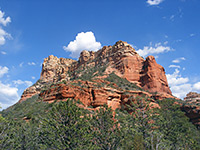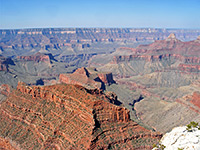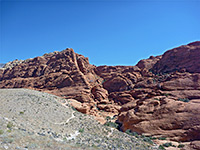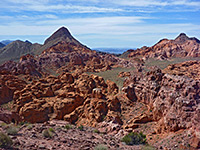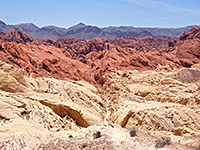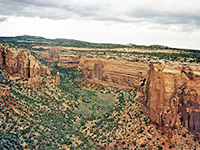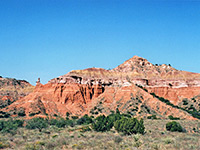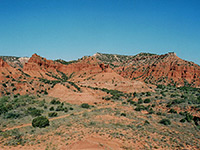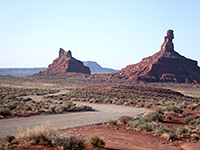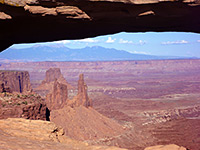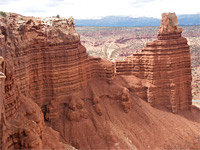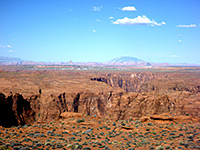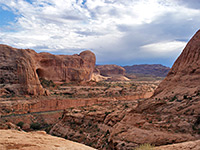As with several other Southwest features (ancient ruins, slot canyons, arches), red rock landscapes are mostly found on the Colorado Plateau of north Arizona, south Utah and southwest Colorado. The sedimentary strata underlying this large region are colored various shades of red, yellow and grey, and exposed in many places, either in canyons, plateau edges or other eroded formations.
The most famous location in Arizona is Sedona, a popular town at the mouth of Oak Creek Canyon, surrounded by cliffs, mesas and other canyons, all formed of deep red Schnebly Hill sandstone and Hermit shale. Much of the land is part of three wilderness areas, largest being Red Rock Secret Mountain Wilderness to the west. On the south side of town, Red Rock State Park also has a few reddish outcrops, though the main feature is a wooded section of Oak Creek. Further west, Sycamore Canyon is a similar but harder-to-reach region, and generally more overgrown. There are also several small, secret places on the Indian reservations of the northeast, such as Blue Canyon.
Red rocks also feature prominently in the Grand Canyon, especially the Supai group and the Redwall limestone, part of a vast landscape that most people view from afar, though various trails descend into the canyon and give a more close-up perspective. Canyon de Chelly is another popular red-walled ravine, again usually viewed mostly from the rim, as the majority is open only to Navajo guided exploration. Some of the most extensive red cliffs in Arizona are found either side of Marble Gorge, at the upper end of the Grand Canyon - these are the Echo Cliffs to the east and the Vermilion Cliffs to the west; this latter is part of a BLM-run national monument, bordered on the north side by unusual eroded red rock formations like Coyote Buttes and the Wave.
California has a Red Rock Canyon State Park, containing a shallowish ravine with eroded formations, even though much of the rocks are white or grey rather than red. Similarly, the scenery in Red Rock Canyon National Conservation Area near Las Vegas in south Nevada is not predominantly red either - the preserve does include a range of red and yellow mounds (Calico Hills) which are surrounded by extensive desert flats bordered by the Spring Mountains, which are generally grey or brownish in color. The bright red rock of the Calico Hills is Aztec sandstone, also seen exposed in several other locations around Lake Mead including Bowl of Fire, Whitney Pockets, and most spectacularly Valley of Fire State Park, where, like the NCA it is mixed with yellow and pink strata to create a very colorful landscape. A more remote area nearby, with less color variation but a greater range of formations, is Little Finland, reached by a 4WD track or a 4 mile cross-country hike.
There are two well known red rock locations in Colorado. In the southwest, Colorado National Monument features a branched, sheer-walled canyon of Entrada, Kayenta and Wingate sandstone, a typical Colorado Plateau drainage. Far away on the east side of the Rocky Mountains, Garden of the Gods is a more unusual location, with a series of thin, jagged ridges created by erosion of deep red Lyons sandstone upturned by nearly 90 degrees. The park adjoins Colorado Springs so is very popular.
Texas is not associated with either red rocks or canyons, but two examples of both are found in the generally flat lands of the northern Panhandle - Palo Duro Canyon State Park and Caprock Canyons State Park preserve eroded escarpments and branched drainages, along the dividing line between the High Plains of the northwest and Rolling Plains to the south.
Perhaps the best known red rock landscape in Utah, if not the whole Southwest, is Monument Valley, in the far south of the state extending into Arizona. All lies within the Navajo Indian Reservation, and the best parts are contained within a Navajo Tribal Park, toured by a rather bumpy 17 mile scenic backroad (Valley Drive).
Nearby Valley of the Gods has similar scenery, much less visited and not subject to any access restrictions. Elsewhere on the Colorado Plateau in Utah are vast areas where red rocks predominate, especially in the Arches, Bryce Canyon, Canyonlands, Capitol Reef, Glen Canyon and Grand Staircase-Escalante national parks. Some smaller areas include:
The most famous location in Arizona is Sedona, a popular town at the mouth of Oak Creek Canyon, surrounded by cliffs, mesas and other canyons, all formed of deep red Schnebly Hill sandstone and Hermit shale. Much of the land is part of three wilderness areas, largest being Red Rock Secret Mountain Wilderness to the west. On the south side of town, Red Rock State Park also has a few reddish outcrops, though the main feature is a wooded section of Oak Creek. Further west, Sycamore Canyon is a similar but harder-to-reach region, and generally more overgrown. There are also several small, secret places on the Indian reservations of the northeast, such as Blue Canyon.
Red rocks also feature prominently in the Grand Canyon, especially the Supai group and the Redwall limestone, part of a vast landscape that most people view from afar, though various trails descend into the canyon and give a more close-up perspective. Canyon de Chelly is another popular red-walled ravine, again usually viewed mostly from the rim, as the majority is open only to Navajo guided exploration. Some of the most extensive red cliffs in Arizona are found either side of Marble Gorge, at the upper end of the Grand Canyon - these are the Echo Cliffs to the east and the Vermilion Cliffs to the west; this latter is part of a BLM-run national monument, bordered on the north side by unusual eroded red rock formations like Coyote Buttes and the Wave.
There are two well known red rock locations in Colorado. In the southwest, Colorado National Monument features a branched, sheer-walled canyon of Entrada, Kayenta and Wingate sandstone, a typical Colorado Plateau drainage. Far away on the east side of the Rocky Mountains, Garden of the Gods is a more unusual location, with a series of thin, jagged ridges created by erosion of deep red Lyons sandstone upturned by nearly 90 degrees. The park adjoins Colorado Springs so is very popular.
Texas is not associated with either red rocks or canyons, but two examples of both are found in the generally flat lands of the northern Panhandle - Palo Duro Canyon State Park and Caprock Canyons State Park preserve eroded escarpments and branched drainages, along the dividing line between the High Plains of the northwest and Rolling Plains to the south.
Perhaps the best known red rock landscape in Utah, if not the whole Southwest, is Monument Valley, in the far south of the state extending into Arizona. All lies within the Navajo Indian Reservation, and the best parts are contained within a Navajo Tribal Park, toured by a rather bumpy 17 mile scenic backroad (Valley Drive).
Nearby Valley of the Gods has similar scenery, much less visited and not subject to any access restrictions. Elsewhere on the Colorado Plateau in Utah are vast areas where red rocks predominate, especially in the Arches, Bryce Canyon, Canyonlands, Capitol Reef, Glen Canyon and Grand Staircase-Escalante national parks. Some smaller areas include:
- Buckskin Hollow, St George
- Fisher Towers, Moab
- Flaming Gorge National Recreation Area
- Goblin Valley State Park
- Little Egypt
- Potash Road, Moab
- Red Canyon
- Red Cliffs Recreation Area
- Snow Canyon State Park
- Yant Flat Cliffs
All Contents © Copyright The American Southwest | Comments and Questions | Contribute | Affiliate Marketing Disclosure | Site Map
